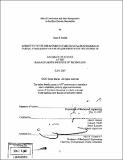| dc.contributor.advisor | John E. Keesee. | en_US |
| dc.contributor.author | Marsh, Jesse B. (Jesse Benjamin) | en_US |
| dc.contributor.other | Massachusetts Institute of Technology. Dept. of Mechanical Engineering. | en_US |
| dc.date.accessioned | 2008-02-27T22:27:24Z | |
| dc.date.available | 2008-02-27T22:27:24Z | |
| dc.date.copyright | 2007 | en_US |
| dc.date.issued | 2007 | en_US |
| dc.identifier.uri | http://hdl.handle.net/1721.1/40453 | |
| dc.description | Thesis (S.B.)--Massachusetts Institute of Technology, Dept. of Mechanical Engineering, 2007. | en_US |
| dc.description | Includes bibliographical references (leaves 28-29). | en_US |
| dc.description.abstract | The Mars Gravity Biosatellite will house fifteen mice in a low Earth orbit satellite spinning about its longitudinal axis. The satellite's payload thermal control system will reject heat through the base of the payload module and provide air circulation vital to maintaining a habitable environment for the mice. The centripetal acceleration due to rotation creates the tendency for heated air to move by free convection toward the axis of rotation. Dominance of forced convection throughout the payload module will ensure nearly isothermal air and effective heat rejection from the payload to the bus module via fan/heatsink/thermoelectric cooler units. Circulation effectiveness is measured by the Richardson number, which expresses the ratio of the influence of free convection to the influence of forced convection in a mixed-convection flow. Experiments were executed with the current circulation system to determine the forced convection flow velocity. The free convection flow parameter was determined theoretically. Cross-flow fan/heatsink units mounted on the baseplate rim created low Reynolds number (88-985) flow throughout the enclosure. The calculated Richardson number for the worst-case 19°C difference between heated components and cooled air is between 0.78 and 2.34. | en_US |
| dc.description.abstract | (cont.) For a realistic steady 3°C-80C temperature difference, the calculated Richardson number for the overall flow field is between 0.22 and 0.37. It was found that the flow capacity of the fan/heatsink assemblies must be increased from 1CFM to 5CFM to achieve the desired dominance of forced convection (a Richardson number of 0.1) in the worst-case on-orbit scenario. Increasing the capacity of the circulation system would allow for recovery from worst-case thermal scenarios under spaceflight conditions and allow a fraction of the cooler units to be powered during normal spaceflight conditions. The methods used here are scalable to analysis for the design of rotating human habitation vehicles. | en_US |
| dc.description.statementofresponsibility | by Jesse B. Marsh. | en_US |
| dc.format.extent | 29 leaves | en_US |
| dc.language.iso | eng | en_US |
| dc.publisher | Massachusetts Institute of Technology | en_US |
| dc.rights | M.I.T. theses are protected by copyright. They may be viewed from this source for any purpose, but reproduction or distribution in any format is prohibited without written permission. See provided URL for inquiries about permission. | en_US |
| dc.rights.uri | http://dspace.mit.edu/handle/1721.1/7582 | |
| dc.subject | Mechanical Engineering. | en_US |
| dc.title | Mixed convection and heat management in the Mars gravity biosatellite | en_US |
| dc.type | Thesis | en_US |
| dc.description.degree | S.B. | en_US |
| dc.contributor.department | Massachusetts Institute of Technology. Department of Mechanical Engineering | |
| dc.identifier.oclc | 191731980 | en_US |
